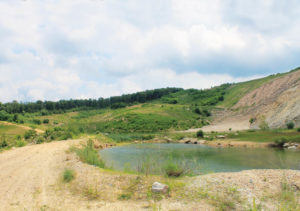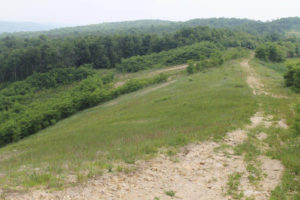By Jill Pack

Project Highlights
Mine closure and reclamation
Chestnut Ridge Sand Quarry
Kunkletown, Pa.
Applications
Erosion control
Slope stabilization
Contractor
The H & K Group
Distributor/Installer
Jobsite Products
Hydraulic erosion control
HydraCM Steep Slope Matrix
HydraCX Extreme Slope Matrix
Quantities
3,414 bales of HydraCX
(about 49 acres)
220 bales of HydraCM
(about 3 acres)
Average application rate
of 3,500 lbs/acre
Introduction
Mining and quarrying sites are shut down for a variety of reasons but it is the lurking hazards that these closures can cause that contractors must work to resolve. These sites can leave a permanent scar if not restored properly, back to a usable habitat. These scars can include disposal of mining waste, requiring erosion and sediment control measures to ensure that the affected land is returned to productive condition.
Regulations, at both federal and state levels, push for land reclamation once a mine has been depleted. These regulations date back to the Mining Act of 1971, which specifies the requirements. Such was the case for the Chestnut Ridge Quarry, located in the small community of Kunkletown, Pa.
At the Chestnut Ridge Quarry, there were more than 100 acres permitted for mining, 75 of which had been put into production during the mine’s lifetime. The geological makeup at the sand quarry, which is an open pit for extracting minerals, created complexities with operations and maintaining water quality in an effective manner that could not sustain a functional mine.
These difficulties led to the closure of the mine and quarry. The site of long, steep slopes with highly erodible soils, which made up what was once a productive mine, had become a ghost site following its permanent closure.
Upon closure, it was important to take the land back to its natural state, as is standard for many closed mines. Reclaiming land in these scenarios can take many forms. To meet state and federal reclamation regulations, the quarry slopes needed to be stabilized and vegetated to protect the site from heavy erosion. The contractor looked for an effective and economical solution that would stabilize the slopes, keeping in mind the need for a safe and vegetated quarry.

Re-establishing the ground
Because of the lack of available topsoil, the erosion control matting selection and seed selection had to be completed on the basis of remediating the soil.
The first phase in the reclamation process was primarily bulk grading to take areas where there was loose and unconsolidated material to a 35-degree angle. The team then used drilling and blasting techniques to take any sheer walls and consolidated material down to a 35-degree angle.
The extremely steep slopes presented the biggest site challenge to the contractor and project overall. Slope lengths and gradients varied from 4:1 (H:V) to 1:1 (H:V) in steepness. Because of the steep grade and non-cohesive soil, grade work could be completed, and hydraulic mulches were selected over the use of erosion control blankets. For the little grading that could be done, the contractor took more equipment and earth moving, creating impoundments to prevent erosion and sedimentation. The average application rate was 3,500 pounds per acre, which is typical for this type of project. This process helped to complete the project on time.
Because of complications specific to this site, the technology the contractor selected needed to facilitate erosion protection that enhanced vegetative growth. Each day without sustained vegetative cover left surface areas exposed to the erosive forces of stormwater, and the longer it took to establish seed meant more time to stabilize the surface and more runoff issues. The vegetation mix selected consisted primarily of legumes due to their nitrogen fixing ability, because any standard conservation mix burned off quickly after germinating.

Finding the right solution
The client wanted to close the quarry and complete the job with the best technology possible. The owners of the quarry wanted a high-end bonded fiber matrix that would get the job done.
“We laid grades back to an acceptable level, flattened everything out, and got rid of vertical faces and any possible safety risks,” said Andy Curtis, the contractor’s environmental compliance officer.
In the project’s last phase, the contractor used hydraulic erosion control materials, applied with a 3,300-gallon hydromulching tank. Installation began in 2011 and was completed in the spring of 2012.
After the vegetation germinated, the site started greening immediately. Now those who drive by the old ghost mine can enjoy the scenery of the newly reclaimed land.
 TEXTILES.ORG
TEXTILES.ORG


